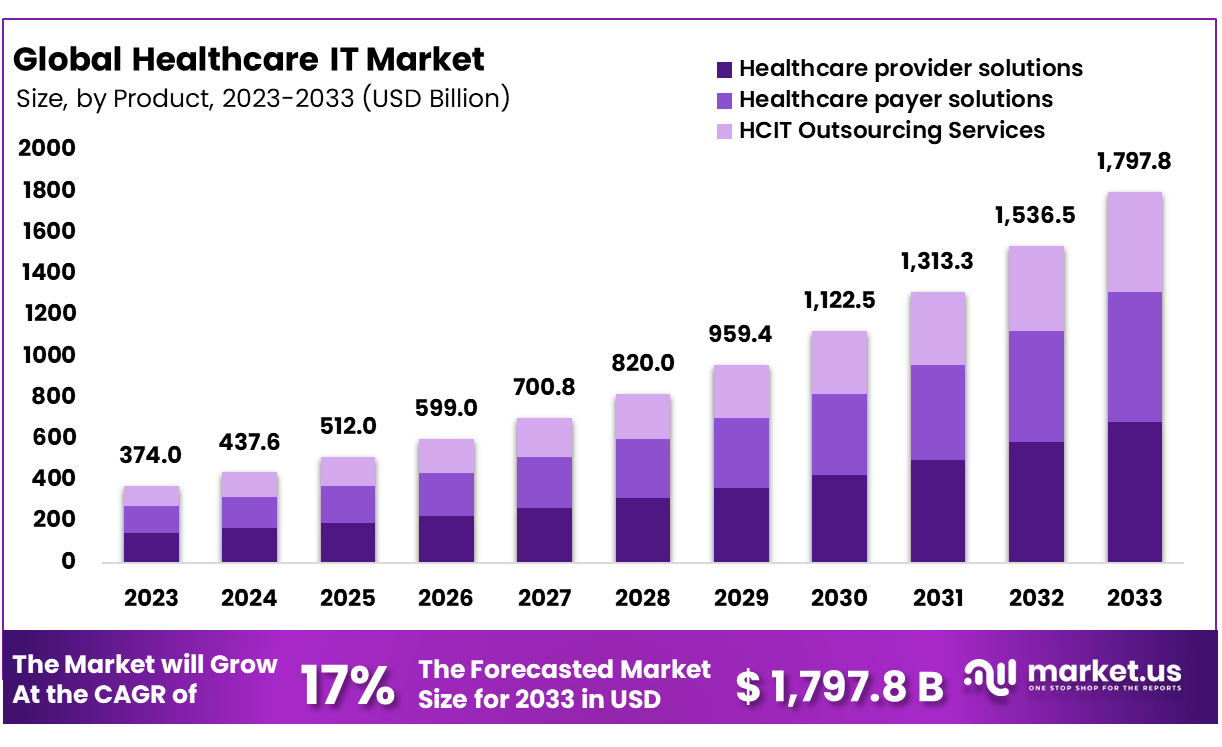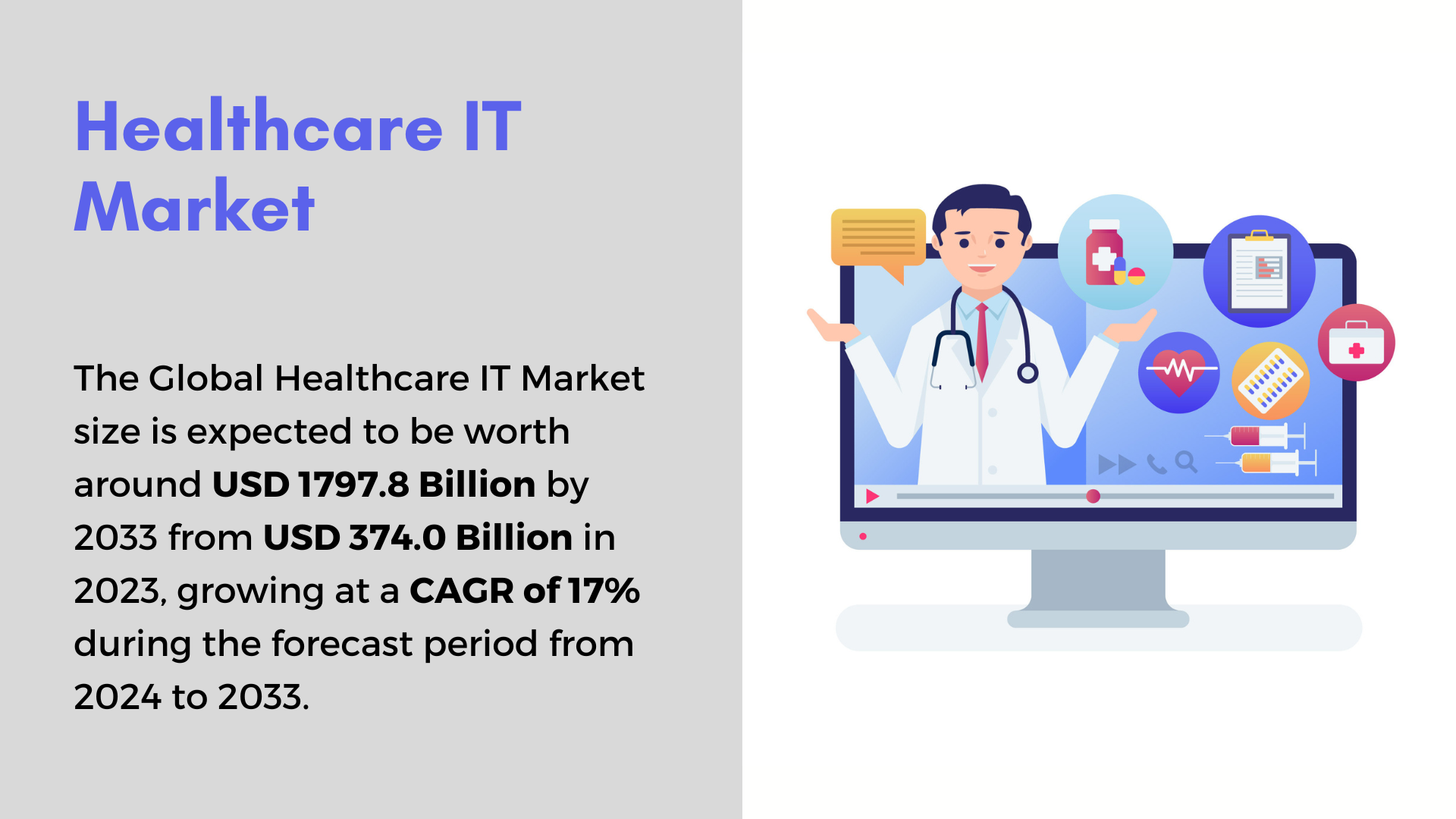Healthcare IT Market Set for Explosive Growth, $1797
Introduction
The global Healthcare IT market is projected to surge from USD 374.0 billion in 2023 to USD 1797.8 billion by 2033, expanding at a compound annual growth rate (CAGR) of 17%. This growth is fueled by several factors, including the integration of artificial intelligence (AI) and machine learning (ML) in healthcare operations. These technologies enhance diagnostic accuracy and improve patient outcomes by facilitating the precise analysis of extensive datasets. Additionally, the emphasis on cybersecurity is escalating as digital health records become more common, necessitating robust protection against data breaches and cyber threats.
Telehealth services, which saw significant expansion during the COVID-19 pandemic, continue to propel the Healthcare IT market. This mode of healthcare delivery has not only made medical services more accessible, especially in underserved or rural areas, but also introduced efficiencies in care provision. The market’s growth is further supported by ongoing policy developments and the integration of internet-based technologies, which ensure a broader reach and continual enhancement in service delivery.
In recent developments, eClinicalWorks launched a new telehealth platform in November 2023, which integrates with existing electronic health records (EHR) systems to improve remote patient monitoring. This innovation is aimed at enhancing healthcare service delivery by enabling more comprehensive and accessible care. Additionally, Carestream Health introduced a new medical imaging system in August 2023 that incorporates AI to boost diagnostic precision and efficiency.
Furthermore, in June 2023, Philips unveiled a new AI-powered diagnostic solution designed to optimize radiology workflows and enhance patient outcomes. This advancement is part of Philips’ commitment to integrating cutting-edge technology into healthcare, aiming to streamline processes and improve radiological interventions. These technological advancements are indicative of the market’s trend towards more sophisticated healthcare solutions that not only streamline service delivery but also significantly enhance diagnostic accuracy and patient care.
Overall, the Healthcare IT market is experiencing transformative growth through technological innovations that make healthcare more efficient, accessible, and effective. The integration of AI and advanced cybersecurity measures in healthcare IT systems is setting new standards in patient care and data protection, aligning with the broader objectives of modern healthcare systems. These developments highlight the industry’s ongoing shift towards enhanced efficiency and precision in patient management and care delivery.
Key Takeaways
- The global healthcare IT market is projected to attain a valuation of USD 1,797.8 billion by 2033, with a CAGR of 17% from 2024 to 2033.
- Healthcare provider solutions dominate the product type segment, capturing a 38% revenue share.
- Services within healthcare IT hold the majority market share, accounting for 52%.
- Healthcare payers are anticipated to generate the highest revenue among end-users.
- The demand for healthcare IT is surging, fueled by advancements in digital tools like telehealth and artificial intelligence.
- Trends indicate that value-based payment models and Accountable Care Organizations (ACOs) are catalyzing partnerships and mergers.
- North America maintains a leading position with a 52% market share, while Europe is poised for rapid growth due to supportive government policies and AI integration.

Healthcare IT Statistics
- Since COVID-19, telemedicine usage has increased by over 150%, enhancing remote patient care and consultations.
- Remote patient monitoring solutions have decreased hospital readmissions by up to 20%, improving home health management.
- Currently, 80% of healthcare providers utilize telehealth services, demonstrating significant adoption of digital consultation tools.
- AI diagnostic tools have reached up to 95% accuracy, advancing early disease detection and treatment outcomes.
- As of July 2024, the healthcare sector in the S&P 500 has grown by 8.98% this year.
- Healthcare IT has slightly underperformed compared to the overall S&P 500 index this year.
- Healthcare stocks saw a 25% drop in quarterly earnings in Q1 2024 compared to Q1 2023.
- In 2023, 70% of healthcare organizations found voice AI beneficial for enhancing workflows and patient care.
- Currently, 44% of healthcare organizations employ voice technology, with an additional 39% planning to adopt it within two years.
- By 2024, the use of voice AI in remote patient monitoring is expected to increase by 25%.
- The adoption of voice-based Electronic Health Records (EHR) is anticipated to rise by 30% in 2024.
- By 2026, 80% of healthcare interactions are expected to involve some form of voice technology.
- From 2012 to 2022, physician services grew at an average annual rate of 4.2%, slower than hospital care (4.4%) and prescription drugs (4.7%).
- In 2022, physician spending increased by 2.6%, influenced by slow growth in prices and utilization.
- Hospital care spending grew by 2.2% in 2022, impacted by subdued price increases and fewer hospital days and discharges.
- Prescription drug spending surged by 8.4% in 2022, driven by higher prices and increased use of retail drugs.
- 42% of global healthcare software buyers identify staff acceptance and training as the primary challenge in new software investments.
- 92% of medical software buyers begin with a shortlist of 3 to 5 vendors.
- 59% of these buyers typically choose a vendor from their initial shortlist.
- 36% of healthcare buyers use customer reviews to research vendor shortlists, while 32% consider product trials crucial for decision-making.
Emerging Trends
- Artificial Intelligence and Machine Learning: The application of artificial intelligence (AI) and machine learning (ML) in healthcare is revolutionizing patient care. These technologies facilitate predictive analytics that anticipate health risks and patient needs. In radiology, AI improves the accuracy of disease monitoring and early detection, streamlining operations and enhancing diagnostic processes. This integration not only boosts efficiency but also improves the overall accuracy of medical assessments.
- Internet of Medical Things (IoMT): The Internet of Medical Things is transforming healthcare by connecting medical devices within a unified system. This connectivity enables real-time patient monitoring and sophisticated data analysis, leading to highly personalized medicine. As a result, health outcomes are improving, thanks to more precise and timely interventions, demonstrating the power of integrated digital healthcare solutions.
- Telehealth and Remote Care: Telehealth is gaining momentum, with a growing number of healthcare providers adopting digital platforms for remote patient management and virtual consultations. This trend is reducing the necessity for in-person visits, making healthcare more accessible. The expansion of telehealth services is particularly crucial in enhancing patient convenience and ensuring continuous care during times when traditional healthcare delivery might be disrupted.
- Extended Reality (XR): Extended reality, encompassing both virtual and augmented reality, is becoming increasingly prevalent in the healthcare sector. These technologies are used for medical training, patient education, and therapeutic purposes. XR offers immersive experiences that enhance learning and treatment, potentially changing how patients and professionals engage with healthcare practices and education.
- Digital Twins and Advanced Simulations: The healthcare industry is embracing digital twins and sophisticated simulations to improve medical procedures. These digital replicas of devices and patient anatomy allow for safe and precise testing of medical interventions. By simulating different scenarios, healthcare professionals can enhance the accuracy and safety of treatments, leading to better patient outcomes.
- Cybersecurity and Data Privacy: As the amount of digital health data increases, so does the need for robust cybersecurity measures. Healthcare institutions are intensifying their efforts to secure patient data against breaches and comply with stringent regulations. Effective cybersecurity strategies are essential in protecting sensitive health information, ensuring patient trust, and maintaining the integrity of healthcare systems.
Use Cases
- Predictive Analytics in Healthcare: Predictive analytics is transforming healthcare management, enhancing both patient flow and equipment maintenance. By employing advanced data analysis, this technology proactively addresses potential medical issues and optimizes operational efficiency. Studies suggest that predictive analytics can resolve up to 30% of potential service cases before they escalate into equipment downtime. This proactive approach is crucial for maintaining continuous care and reducing unexpected operational halts.
- Remote Patient Monitoring (RPM): RPM technologies are pivotal in modern healthcare, offering real-time monitoring and improving patient engagement. These technologies are especially beneficial for individuals with chronic conditions, as they ensure consistent monitoring and adherence to treatment protocols. By integrating RPM, healthcare providers can deliver more personalized and timely care, which significantly enhances overall care management and patient outcomes.
- Population Health Management: Utilizing big data analytics, healthcare providers can gain a deeper understanding of disease patterns and risk factors across various demographics. This insight is essential for developing targeted disease prevention strategies and effective health interventions. By analyzing extensive data sets, healthcare systems can implement more precise and effective approaches to population health management, ultimately improving community health outcomes.
- Wearables and Personal Health Monitoring: The growing adoption of wearable technology in healthcare is instrumental in the shift towards preventive care. These devices continuously monitor vital health metrics, enabling early detection and timely medical interventions. The use of wearables supports a proactive healthcare model, reducing the incidence of emergency treatments and promoting long-term health improvements among users.
- Virtual Hospitals: Virtual care models are revolutionizing the healthcare industry by increasing bed availability and enhancing patient satisfaction. These models allow for the remote management of patients, which not only optimizes healthcare resource utilization but also reduces operational costs. Virtual hospitals represent a significant advancement in making healthcare more accessible and efficient, benefiting both providers and patients alike.
Conclusion
The global Healthcare IT market is poised for substantial growth, driven by technological advancements in AI, telehealth, and cybersecurity. These innovations are not only enhancing diagnostic precision and expanding access to care but are also fortifying data security across digital platforms. The integration of modern technologies like the Internet of Medical Things and extended reality is transforming healthcare delivery, making it more efficient and personalized. As these trends continue to evolve, they are setting new standards for patient care and operational efficiency in the healthcare sector. The market’s robust expansion is indicative of a broader shift towards more integrated and technologically advanced healthcare solutions that promise to improve patient outcomes and streamline healthcare processes globally.
Discuss Your Needs With Our Analyst
Please share your requirements with more details so our analyst can check if they can solve your problem(s)




